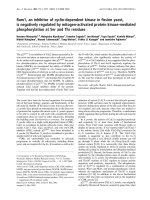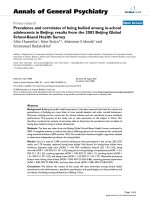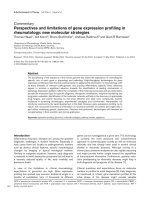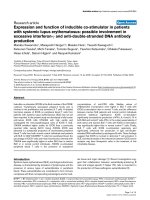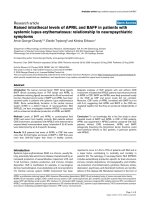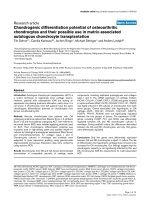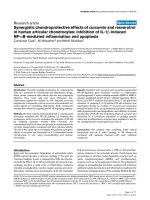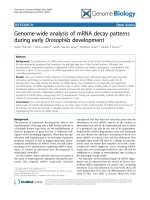Báo cáo y học: "The therapeutic potential of a venomous lizard: the use of glucagon-like peptide-1 analogues in the critically ill" pdf
Bạn đang xem bản rút gọn của tài liệu. Xem và tải ngay bản đầy đủ của tài liệu tại đây (127.55 KB, 3 trang )
In the previous issue of Critical Care Mecott and colleagues
report the eff ects of a glucagon-like peptide-1 (GLP-1)
analogue, exenatide, on glycaemia in severely burned
paediatric patients [1]. e incretin hormones, GLP-1
and glucose-dependent polypeptide (GIP), mediate ~70%
of the insulin response to a meal [2]. While GIP is
potently insulinotropic in health, its eff ect is markedly
attenuated in type 2 diabetic patients, such that even
pharmacological doses have little eff ect on glycaemia [3].
In contrast, physiological replacement or pharmaco-
logical adminis tra tion of GLP-1 lowers glycaemia sub-
stantially in this group [3]. Accordingly, studies in
ambulant type 2 diabetic patients have focused on the
therapeutic potential administration of GLP-1 rather
than GIP. Signifi cantly, the glucose-lowering eff ects of
exogenous GLP-1 are glucose dependent, such that even
pharma co logical doses of GLP-1 are most unlikely to
cause hypo glycaemia.
Native GLP-1 is not used as a glucose-lowering agent in
ambulant type 2 diabetic patients because of the necessity
for continuous administration [4]. Endogenous GLP-1 is
metabolised rapidly to its so-called inactive metabolite by
the ubiquitous enzyme dipeptyl-peptidase-4 (DPP-4), the
half-life of native GLP-1 being ~1 to 2 minutes [5]. While
this factor essentially precludes the use of exogenous
GLP-1 in ambulant patients, rapid metabolism of an
agent may be a desirable pharmacokinetic property in the
hospitalised patient. Accordingly, our group and others
have explored the eff ects of exogenous GLP-1 in a variety
of hospitalised, adult patients [6-10].
Usin g a prospective, randomised, open-label, design,
Mecott and colleagues compared an intervention
(exenatide ± insulin) with a control (intensive insulin
therapy) i n patients receiving small intestinal nutrient.
e authors report that the intervention decreased
insulin requirements while comparable glycaemic control
was achieved. e therapeutic use of GLP-1 in critically
ill patients is inherently attractive as it does not
substantially increase the risk of hypoglycaemia [11]. In
addition, GLP-1 therapies show reduced glycaemic varia-
bility when compared with insulin in ambulant diabetic
patients [11].
Strengths of the study are the evaluation of a GLP-1-
based therapy in a new population (paediatric) that has
suff ered a specifi c insult (burns), and the prolonged
duration of evaluation (up to 28 days). Finally, and per-
haps most signifi cantly, the investigators have elected to
use a GLP-1 analogue (exenatide) rather than the syn-
thetic peptide. e major advantages of exenatide when
compared with GLP-1 are that it can be administered
intermittently, as well as its cheaper price and ready
availability (Table 1).
Limitations of the study, which are largely acknow-
ledged by the authors, include its open-label design and
Abstract
Glucagon-like peptide-1 (GLP-1), a principal mediator
of the postprandial insulinotropic response in health,
has a half-life of minutes. The saliva of the Gila monster
contains exendin-4, a structural analogue of human
GLP-1, but with a much longer half-life. A synthetic
preparation of exendin-4, exenatide, is suitable for
human use and e ectively lowers glucose in ambulant
type 2 diabetic patients. When compared with insulin,
exenatide therapy is associated with a reduction in
hypoglycaemic episodes and postprandial glycaemic
excursions in this group. Accordingly, GLP-1 analogues
are appealing therapies for hyperglycaemia in the
critically ill patient and warrant further study.
© 2010 BioMed Central Ltd
The therapeutic potential of a venomous lizard:
the use of glucagon-like peptide-1 analogues in
the critically ill
Adam M Deane*
1,2,3
, Marianne J Chapman
1,2,3
and Michael Horowitz
3,4
See related research by Mecott et al., />COMMENTARY
*Correspondence:
1
Discipline of Acute Care Medicine, University of Adelaide, North Terrace, Adelaide,
South Australia, Australia 5000
Full list of author information is available at the end of the article
Deane et al. Critical Care 2010, 14:1004
/>© 2010 BioMed Central Ltd
the relatively small number of subjects studied, with the
consequent potential for type 2 errors. e authors
reported that the use of the GLP-1 analogue failed to
reduce hypoglycaemic episodes and glycaemic variability.
However, the lack of eff ect on variability and hypo-
glycaemia may refl ect administration of exenatide ±
insulin, rather than using exenatide as a single agent.
Plasma exenatide concentrations were not reported, and
it should be recognised that concentrations may not be
predictable in these subjects – since, even in healthy
subjects, exenatide has a biological half-life of ~3 hours
and large fl uctuations in plasma levels occur with twice-
daily subcutaneous administration. Furthermore, given
the limited infor mation on the mechanisms of glucose-
lowering in the critically ill patient, measurement of
insulin and/or C-peptide, as well as glucagon, would have
been valuable.
Exendin-4 was isolated originally from the saliva of the
Gila monster (Heloderma suspectum), a slow-moving
venomous lizard native to the United States and Mexico.
e Gila monster eats only 5 to 10 times per year and a
meal causes a substantial postprandial increase in plasma
exendin-4 concentrations [12]. Exendin-4 shares ~50%
amino acid sequence identity with human GLP-1 and
binds to the pancreatic GLP-1 receptor in vitro. Impor-
tantly, exendin-4 is resistant to DPP-4 inactivation,
thereby having a prolonged duration of action [12].
Exenatide, a synthetic form of exendin-4, has been shown
to reduce fasting and postprandial glucose via glucose-
dependent stimulation of insulin and suppression of
glucagon secretion, as well as slowing gastric emptying
[13]. e latter is probably the dominant mechanism to
account for glucose lowering after oral or intragastric
meals in healthy subjects, type 2 diabetic patients, and
those critically ill patients in whom gastric emptying is
normal [10,13]. GLP-1 analogues with half-lives between
12 hours and 3 to 4 days have been recently developed.
ese analogues have less variation in plasma concen-
trations after once-daily (for example, liraglutide) or
weekly (sustained release exenatide) administration than
twice a day dosing (exenatide). Oral drugs that inactivate
the DPP-4 enzyme (DPP-4 inhibitors) – thereby
attenuating metabolism and increasing the availability of
endogenous GLP-1 and GIP – have also entered the
clinical domain (Table 1).
In the study of Mecott and colleagues, exenetide was
well tolerated; but given the adverse eff ects associated
with its use in ambulant diabetic patients, ongoing
vigilance is warranted. ese adverse eff ects include
nausea and vomiting (usually transient) [14], as well as
modest weight loss that occurs, and is frequently
desirable, in ambulant type 2 diabetic patients [14], but
may be detrimental in the critically ill patient. e
potential association between GLP-1 analogues and
pancreatitis remains uncertain [14]. Lastly, the investi-
gators did not measure anti-exenatide antibodies or
plasma calcitonin concentrations, but the signifi cance of
anti-exenatide antibiodies or mild increases in calcitonin
concentrations is unclear [14].
Albeit preliminary, the present study represents part of
a growing interest in the use of incretins, or incretin
mimetics, for the management of hyperglycaemia in
hospitalised patients [15]. e desirable blood glucose
range in this group remains contentious, but, as with
recent studies in ambulant type 2 diabetic patients, there
seems to be minimal, or no, advantage in targeting
glycaemia at the lower end of the fasting normal range.
Rather, the latter may well be deleterious [16]. Because
the glucose-lowering eff ect of GLP-1 is glucose
dependent, there is likely to be a threshold – perhaps
Table 1. Comparison between GLP-1, GLP-1 analogues and DPP-4 inhibitors
GLP-1 GLP-1 analogues DPP-4 inhibitors
Name(s) GLP-1-(7-36)NH
2
Exena tide Sitagliptin
Lir aglutide Vildagliptin
Saxagliptin
Administration Intravenous Subcutaneous Oral
Studied in the critically ill patient Yes Yes No
Current cost Prohibitive Expensive Expensive
Availabil ity Limited Yes Yes
Half -life 1 to 2 minutes 2 to 15 hours 2 to 14 hours
Additional e ects mediated via inactive GLP-1 Yes No No
Nausea Yes Yes No
Weight Loss Loss Weight neutral
Gastric emptying Slows Slows Minimal, if any, e ect
DPP-4, dipeptyl-peptidase-4; GLP-1, glucagon-like peptide-1.
Deane et al. Critical Care 2010, 14:1004
/>Page 2 of 3
about 7 to 8 mmol/l – beyond which further reductions
will only occur if exogenous insulin is co-administered.
In addition to identifying the optimal glycaemic range,
future studies should focus on the following: which of the
incretin agents is most useful in the critically ill patient;
whether these agents should be used in combination with
insulin, or as single-agent therapy; and identifi cation of
the patient group most likely to benefi t from
administration of incretin mimetics.
Abbreviations
DPP-4, dipeptyl-peptidase-4; GIP, glucose-dependent polypeptide; GLP-1,
glucagon-like peptide-1.
Competing interests
The authors declare that they have no competing interests.
Author details
1
Discipline of Acute Care Medicine, University of Adelaide, North Terrace,
Adelaide, South Australia, Australia 5000.
2
Intensive Care Unit, Level 4,
Emergency Services Building, Royal Adelaide Hospital, North Terrace, Adelaide,
South Australia, Australia 5000.
3
National Health and Medical Research Council
of Australia Centre for Clinical Research Excellence in Nutritional Physiology
and Outcomes, Level 6, Eleanor Harrald Building, North Terrace, Adelaide,
South Australia, Australia 5000.
4
Discipline of Medicine, University of Adelaide,
Royal Adelaide Hospital, Level 6 Eleanor Harrald Building, North Terrace,
Adelaide, South Australia, Australia 5000.
Published: 21 October 2010
References
1. Mecott GA, Herndon DN, Kulp GA, Brooks N, Al-Mousawi AM, Kraft R, Rivero
HG, Williams FN, Branski LK, Jeschke MG: The use of exenatide in severely
burned pediatric patients. Crit Care 2010, 14:R153.
2. Nauck MA, Homberger E, Siegel EG, Allen RC, Eaton RP, Ebert R, Creutzfeldt W:
Incretin e ects of increasing glucose loads in man calculated from venous
insulin and C-peptide responses. J Clin Endocrinol Metab 1986, 63:492-498.
3. Nauck MA, Heimesaat MM, Orskov C, Holst JJ, Ebert R, Creutzfeldt W:
Preserved incretin activity of glucagon-like peptide 1 [7-36 amide] but not
of synthetic human gastric inhibitory polypeptide in patients with type-2
diabetes mellitus. J Clin Invest 1993, 91:301-307.
4. Nauck MA, Wollschlager D, Werner J, Holst JJ, Orskov C, Creutzfeldt W, Willms
B: E ects of subcutaneous glucagon-like peptide 1 (GLP-1 [7-36 amide]) in
patients with NIDDM. Diabetologia 1996, 39:1546-1553.
5. Deacon CF: What do we know about the secretion and degradation of
incretin hormones? Regul Peptides 2005, 128:117-124.
6. Nauck MA, Walberg J, Vethacke A, El-Ouaghlidi A, Senkal M, Holst JJ, Gallwitz
B, Schmidt WE, Schmiegel W: Blood glucose control in healthy subject and
patients receiving intravenous glucose infusion or total parenteral
nutrition using glucagon-like peptide 1. Regul Peptides 2004, 118:89-97.
7. Meier JJ, Weyhe D, Michaely M, Senkal M, Zumtobel V, Nauck MA, Holst JJ,
Schmidt WE, Gallwitz B: Intravenous glucagon-like peptide 1 normalizes
blood glucose after major surgery in patients with type 2 diabetes. Crit
Care Med 2004, 32:848-851.
8. Sokos GG, Bolukoglu H, German J, Hentosz T, Magovern GJ Jr, Maher TD, Dean
DA, Bailey SH, Marrone G, Benckart DH, Elahi D, Shannon RP: E ect of
glucagon-like peptide-1 (GLP-1) on glycemic control and left ventricular
function in patients undergoing coronary artery bypass grafting. Am J
Cardiol 2007, 100:824-829.
9. Deane AM, Chapman MJ, Fraser RJ, Burgstad CM, Besanko LK, Horowitz M:
The e ect of exogenous glucagon-like peptide-1 on the glycaemic
response to small intestinal nutrient in the critically ill: a randomised
double-blind placebo-controlled cross over study. Crit Care 2009, 13:R67.
10. Deane AM, Chapman MJ, Fraser RJ, Summers MJ, Zaknic AV, Storey JP, Jones
KL, Rayner CK, Horowitz M: E ects of exogenous glucagon-like peptide-1
on gastric emptying and glucose absorption in the critically ill:
relationship to glycemia. Crit Care Med 2010, 38:1261-1269.
11. Heine RJ, Van Gaal LF, Johns D, Mihm MJ, Widel MH, Brodows RG: Exenatide
versus insulin glargine in patients with suboptimally controlled type 2
diabetes: a randomized trial. Annals Internal Med 2005,
143:559-569.
12. Kolterman OG, Buse JB, Fineman MS, Gaines E, Heintz S, Bicsak TA, Taylor K,
Kim D, Aisporna M, Wang Y, Baron AD: Synthetic exendin-4 (exenatide)
signi cantly reduces postprandial and fasting plasma glucose in subjects
with type 2 diabetes. J Clin Endocrinol Metab 2003, 88:3082-3089.
13. Linnebjerg H, Park S, Kothare PA, Trautmann ME, Mace K, Fineman M, Wilding
I, Nauck M, Horowitz M: E ect of exenatide on gastric emptying and
relationship to postprandial glycemia in type 2 diabetes. Regul Peptides
2008, 151:123-129.
14. Drucker DJ, Nauck MA: The incretin system: glucagon-like peptide-1
receptor agonists and dipeptidyl peptidase-4 inhibitors in type 2 diabetes.
Lancet 2006, 368:1696-1705.
15. Deane A, Chapman MJ, Fraser RJ, Horowitz M: Bench-to-bedside review: The
gut as an endocrine organ in the critically ill. Crit Care 2010, 14:228.
16. Finfer S, Chittock DR, Su SY, Blair D, Foster D, Dhingra V, Bellomo R, Cook D,
Dodek P, Henderson WR, Hébert PC, Heritier S, Heyland DK, McArthur C,
McDonald E, Mitchell I, Myburgh JA, Norton R, Potter J, Robinson BG, Ronco
JJ: Intensive versus conventional glucose control in critically ill patients.
NEngl J Med 2009, 360:1283-1297.
doi:10.1186/cc9281
Cite this article as: Deane AM, et al.: The therapeutic potential of a
venomous lizard: the use of glucagon-like peptide-1 analogues in the
critically ill. Critical Care 2010, 14:1004.
Deane et al. Critical Care 2010, 14:1004
/>Page 3 of 3

